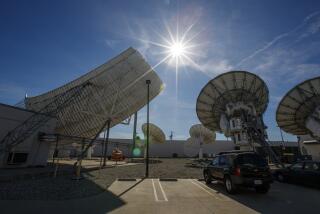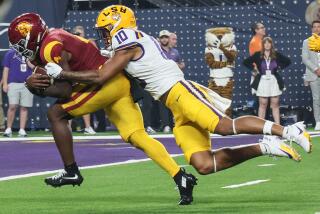Switch to digital TV will benefit you plenty, FCC says
Now that June 12 has come and gone, it may be time to ask: Who, if anyone, benefits from the mandatory upgrade to digital television transmission?
The move inconvenienced millions of Americans who had to obtain converter boxes for their old analog television sets. The government spent billions preparing the viewing public.
But advocates and regulators say the expense and hassle was worth it.
The government received $19.6 billion for the nearly 1,100 spectrum licenses it sold in 2008, depositing that money into the Treasury. And the nation will have access to faster Internet connections, better emergency services, and sharper TV pictures and better sound, said Michael J. Copps, acting chairman of the Federal Communications Commission.
“It’s going to be a win-win situation,” he said in a meeting with The Times this week. “Broadcasters can’t just say we’re going to be exempt from digital.”
Digital broadcasting represents a more efficient use of the spectrum, analysts said. It takes fewer airwaves to transmit a digital signal than it does an analog one, which means companies can use the reclaimed airwaves to enhance communication, said Michael Calabrese, director of the Wireless Future Program at the New America Foundation, a nonprofit, nonpartisan public policy institute.
“It frees up the airwaves for wireless broadband and other innovation, which is really the biggest benefit,” he said.
By taking back television channels 52 to 69, the government gets valuable airwaves that can carry lots of information across long distances and easily penetrate bad weather and barriers such as houses and trees, he said. Less than 15% of the population used the airwaves to receive TV broadcasts, making it inefficient to use the spectrum for TV.
These airwaves will allow for more capacity in wireless broadband and cellphone coverage, and telecom companies such as AT&T; Inc. and Verizon Wireless, which purchased large chunks of spectrum, are relying on them to roll out high-speed cellular networks.
Verizon spent $9.36 billion for blocks of airwaves the company said it would use to roll out faster wireless Internet service powered by a technology called Long Term Evolution.
Verizon spokesman Ken Muche said that as soon as the digital transition was complete, the company would move into select markets “and begin building the first 4G network in the U.S.” Verizon plans to launch 4G networks in 20 to 30 major U.S. markets next year.
The 4G, or Fourth Generation, networks will provide much faster wireless Internet connections that could enable consumers to watch 3-D television on their phones, seamlessly view Web videos and conduct videoconferences on their phones. The airwaves can penetrate buildings more easily, which will provide better reception in problem spots, Muche said.
“The promise of [Long Term Evolution] is truly extraordinary: potential average speeds of five to 12 megabits per second,” he said.
The faster wireless service from Verizon and other telecom companies won’t be free for customers. But if the cost for delivering bytes of information falls, prices may fall too, according to Charles Golvin, an industry analyst for Forrester Research.
“If the wireless operators are aggressive in trying to sell broadband services, then this could lead to better competition and low prices for consumers,” he said.
Consumers might also benefit from the empty airwaves, or “white spaces,” between the new digital TV channels. A group of tech companies including Google Inc., Microsoft Corp. and Dell Inc. lobbied for unlicensed use of those frequencies, and the FCC voted in November to do so. That’s expected to increase speeds and availability of Wi-Fi connections.
For those who don’t use a computer, the digital switch could also enhance broadcast TV viewing, said Copps, the FCC acting chairman.
Viewers will gain “sharper picture, better sound, more free over-the-air broadcast channels,” he said.
Broadcast stations can send out several streams of video over the same digital channel, allowing them to show more diverse programming, said Shermaze Ingram, a spokeswoman for the National Assn. of Broadcasters.
Los Angeles public TV station KCET is already broadcasting four channels: a Spanish-language channel called V-ME, an HD channel called KCET HD, a lifestyle channel called Orange, and PBS World, which broadcasts news and talk shows.
Anyone with a digital TV or converter box could get those channels now, said Gordon Bell, KCET-TV’s vice president of engineering, and the cable companies have said that they would soon start broadcasting them as part of an agreement linked to the digital transition.
One potential benefit of the switch is still in the works. Four channels of the spectrum were designated for public safety use, potentially allowing police and fire departments from different jurisdictions to communicate on the same network. During their response to the Sept. 11, 2001, terrorist attacks, police and firefighters were prevented from communicating in some areas because their devices were incompatible, partly because they weren’t using the same frequencies.
The government had hoped a company would step forward to build a public-private network on the spectrum that would allow police, firefighters and other emergency personnel to share information, but no one bid the $1.3-billion minimum required. Copps said the new FCC chief would have to come up with a new plan to build such a network.
Despite the potential benefits, Craig Carr of West Hills doesn’t think the transition from analog to digital is worth the hassle. Carr, who once performed for the Ice Capades and is producing his own Las Vegas ice show, said he’ll just spend more time beading costumes when his TV goes dark.
He doesn’t have enough money to buy a new TV, he said, and the converter box he bought doesn’t work with the TV he has. And though he won’t be able to watch the news or ABC’s “Dancing With the Stars” anymore, Carr said he has a solution for when he gets bored: “I’ll just have to pop in a VHS tape and watch that.”
--



